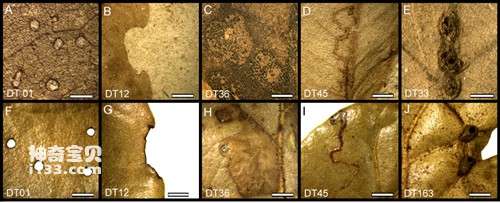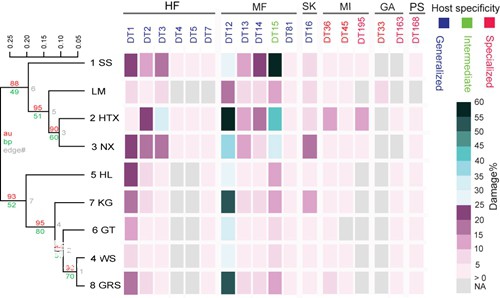Insects and plants are the most important components of forest ecosystems. Studying the relationship between insects and plants is particularly important for understanding the maintenance and evolution mechanisms of ecosystems in the context of climate change. Plant leaf fossils contain abundant forms of insect feeding remains, making them excellent materials for studying the evolution of the relationship between herbivorous insects and plants.
Quercus section Heterobalanus is a plant of the genus Quercus in the Fagaceae family. It is not only the dominant species in modern forest vegetation in southwestern my country, especially the Hengduan Mountains, but also has rich leaf fossil records. Su Tao, associate researcher of the Paleoecology Group of the Banna Botanical Garden, and others used the upper Pliocene Longmen flora of Yongping County in western Yunnan and eight modern alpine oak forest samples collected from Yunnan, Sichuan and Tibet as materials to compare fossil and modern alpine oak. The morphological composition and differences of insect feeding in leaves were discussed. The evolution of insect feeding behavior in alpine oak forests under the background of Quaternary climate change was discussed. The results show that the diversity of insect feeding forms in modern samples is significantly positively correlated with the average annual temperature; except for one gall type, the insect feeding forms of alpine oak leaves in the Longmen flora can be found in modern samples; In addition, all modern samples have significantly more feeding morphological taxa than the Longmen flora, although the average annual temperature of the Longmen flora is significantly higher than that of any modern site. It can be seen that Quaternary climate change has not reduced the diversity of insect feeding forms in alpine oak forests. On the contrary, this diversity has been enhanced. This study supports the "cumulative effect" hypothesis of ecosystem evolution, that is, in stable forest vegetation, as time goes by, the relationship between animals and plants will gradually strengthen. It also shows that plants play an important role in insect diversity. The role of "Evolutionary Island". This study pioneered the combination of fossils and modern samples to explore the evolution of herbivorous insect feeding behavior under the background of climate change, providing new ideas for understanding the evolutionary history of the relationship between animals and plants in modern ecosystems.

Figure 1 Comparison of insect feeding morphology between fossil alpine oak leaves and modern samples. A-E: Fossils; F-J: Modern samples. The feeding patterns of A-D and F-I are consistent, while E and J are different.

Figure 2 Heat map and cluster analysis illustrate the composition and differences in insect feeding morphology between fossil sites (LM) and modern samples.
animal tags:
We created this article in conjunction with AI technology, then made sure it was fact-checked and edited by a Animals Top editor.